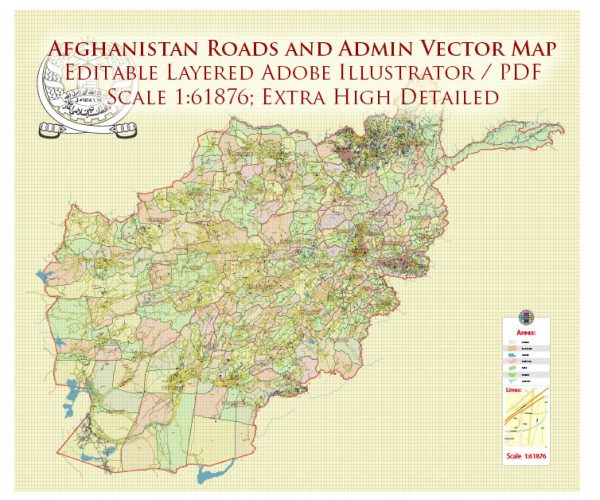Afghanistan is a landlocked country located in South Asia and Central Asia.
Vectormap.Net provide you with the most accurate and up-to-date vector maps in Adobe Illustrator, PDF and other formats, designed for editing and printing. Please read the vector map descriptions carefully.
Here is a detailed description covering various aspects of Afghanistan:
1. Geography:
- Location: Afghanistan is situated in the heart of Asia, sharing borders with Pakistan to the east and south, Iran to the west, Turkmenistan, Uzbekistan, and Tajikistan to the north, and China to the northeast.
- Topography: The country is characterized by a diverse landscape, including rugged mountains, vast deserts, and fertile plains. The Hindu Kush mountain range dominates much of the country, influencing its climate and geography.
2. Capital and Major Cities:
- Capital: Kabul is the capital and largest city of Afghanistan.
- Other Major Cities: Other significant cities include Herat, Kandahar, Mazar-i-Sharif, Jalalabad, and Kunduz.
3. Population:
- Afghanistan have a population of over 38 million people, comprising various ethnic groups, including Pashtuns, Tajiks, Hazaras, Uzbeks, and others.
4. Languages:
- The official languages are Pashto and Dari (a variety of Persian). English is also widely used in official and business contexts.
5. Religion:
- The majority of Afghans are Muslims, with the majority following Sunni Islam.
6. History:
- Afghanistan has a rich history that spans thousands of years. It has been a crossroads for various civilizations, including the Persian Empire, Greek Empire (Alexander the Great), and the Silk Road trade route.
- In recent decades, Afghanistan has faced significant challenges, including Soviet occupation (1979-1989), civil war (1992-1996), and the Taliban rule (1996-2001).
7. Recent Developments:
- Afghanistan has been a focal point of international attention due to the presence of the Taliban, an Islamist militant group that controlled the country from 1996 to 2001 and regained power in August 2021.
- The U.S. and its allies were involved in military operations in Afghanistan for nearly two decades, officially ending with the withdrawal of U.S. forces in 2021. The situation remained complex, with ongoing political, security, and humanitarian challenges.
8. Economy:
- Afghanistan’s economy has historically been agrarian, with a significant portion of the population engaged in agriculture. The country has rich natural resources, including minerals and natural gas.
- Ongoing conflicts have had a considerable impact on the economy, and reconstruction efforts have faced numerous challenges.
9. Culture:
- Afghan culture is a blend of various influences, reflecting its historical position as a crossroads of civilizations.
- Traditional music, dance, and poetry are integral to Afghan culture. The Afghan cuisine is diverse, with influences from Persian, Indian, and Central Asian cuisines.
10. Challenges:
- Afghanistan has faced persistent challenges, including political instability, security concerns, and issues related to human rights, particularly concerning the status of women.


 Author: Kirill Shrayber, Ph.D.
Author: Kirill Shrayber, Ph.D.